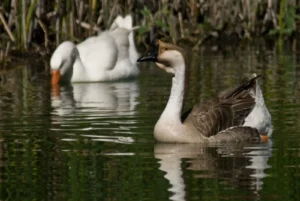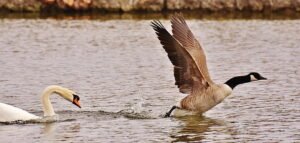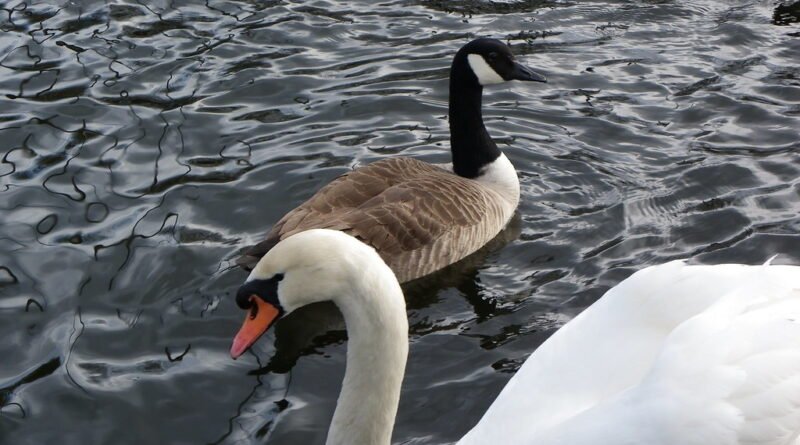Comparative Analysis: Swan vs. Goose
I. Introduction
A. Introduction to Swans and Geese
Swans and geese are both members of the Anatidae family, characterized by their large size, webbed feet, and strong migratory instincts. Swans are known for their graceful appearance and elegant necks, while geese are recognized for their distinctive honking calls and V-shaped flight formations.
B. Significance of Comparative Study
Understanding the differences and similarities between swans and geese is essential for gaining insights into their ecological roles, behavioral adaptations, and evolutionary relationships. This comparative analysis provides a comprehensive overview of these two avian groups, shedding light on their respective habitats, feeding habits, social behaviors, and conservation status.
II. Taxonomy and Classification
A. Taxonomic Classification
Swans belong to the genus Cygnus, while geese are classified under the genera Anser and Branta. Both swans and geese are part of the family Anatidae, which also includes ducks and other waterfowl species. Within this family, swans are further classified into six species, while geese comprise numerous species and subspecies distributed across the globe.
B. Morphological Differences
Swans are generally larger than geese, with longer necks and proportionally larger bodies. They often exhibit pure white plumage, although some species may have black markings on their heads or necks. In contrast, geese come in a variety of colors, including white, gray, and brown, with distinctive patterns on their plumage. Geese also have shorter necks compared to swans and may have different bill shapes, depending on their feeding preferences.
III. Habitat and Distribution
A. Habitat Preferences
Swans are typically found in freshwater habitats such as lakes, ponds, and rivers, where they feed on aquatic plants and invertebrates. Geese, on the other hand, inhabit a wider range of environments, including wetlands, grasslands, agricultural fields, and coastal estuaries. They are more adaptable to different habitat types and can be found in both rural and urban settings.
B. Global Distribution
Swans are distributed across the Northern Hemisphere, with species such as the mute swan (Cygnus olor) found in Europe, Asia, and North America. Geese have a more widespread distribution, occurring on every continent except Antarctica. Many goose species undertake long-distance migrations between breeding and wintering grounds, with some traveling thousands of miles each year.
IV. Feeding Ecology and Dietary Preferences

A. Feeding Behavior
Swans are primarily herbivorous, feeding on aquatic vegetation, algae, and submerged plants. They use their long necks to reach underwater vegetation while swimming or dabbling in shallow water. Geese have a more varied diet, incorporating both plant matter and invertebrates into their meals. They graze on grasses, grains, and agricultural crops, as well as forage for aquatic plants and insects in wetland habitats.
B. Dietary Adaptations
Swans have specialized adaptations for filter-feeding, using their unique bill structures to strain small organisms and algae from the water. They may also upend in shallow water to reach submerged vegetation with their bills. Geese have adapted to feed on a wider range of food items, including grasses, sedges, and agricultural crops. Some species, such as the snow goose (Anser caerulescens), are known for their ability to strip grasses and crops with their serrated bills.
V. Social Structure and Behavior
A. Group Dynamics
Swans are often seen in monogamous pairs or small family groups, particularly during the breeding season. They may form large flocks during migration or wintering periods, but breeding pairs remain territorial and defend their nesting sites aggressively. Geese are highly social birds that form large flocks year-round, often congregating in open fields or bodies of water. They exhibit complex social hierarchies within their flocks, with dominant individuals asserting control over resources and territory.
B. Breeding Biology
Swans and geese both engage in elaborate courtship rituals during the breeding season, involving displays of aggression, vocalizations, and synchronized movements. Swans build large, conspicuous nests of reeds, grasses, and other plant materials, typically situated near the water’s edge. Geese construct more modest nests on the ground, lined with feathers, down, and other soft materials. Both species invest significant time and energy into incubating their eggs and caring for their young.
VI. Vocalizations and Communication
A. Vocal Repertoire
Swans are known for their soft, melodious calls, which are often used for communication between mates and family members. They may also hiss or trumpet loudly when threatened or alarmed. Geese are more vocal and expressive, producing a variety of honking, cackling, and hissing sounds. These vocalizations serve as territorial displays, mating calls, and warnings to other members of the flock.
B. Communication Signals
In addition to vocalizations, swans and geese use body language, posturing, and visual displays to communicate with one another. They may engage in ritualized behaviors such as head bobbing, wing flapping, and bill fencing to establish dominance or attract mates. Aggressive encounters between individuals may involve threatening gestures, such as raised wings or inflated necks, to assert dominance and resolve conflicts within the flock.
VII. Ecological Roles and Conservation Status

A. Ecosystem Services
Both swans and geese play important ecological roles within their respective habitats. As herbivores, they help maintain the balance of plant communities by grazing on vegetation and controlling overgrowth in wetlands and grasslands. Swans also contribute to nutrient cycling in aquatic ecosystems through their feeding and foraging activities.
B. Conservation Concerns
Swans and geese face numerous threats to their populations, including habitat loss, pollution, hunting, and climate change. Wetland degradation and urban development have resulted in the loss of critical breeding and feeding habitats for both species. Illegal hunting and poaching pose additional risks, particularly for migratory populations that face exploitation along their migration routes. Climate change is also affecting the availability of suitable breeding and wintering grounds for swans and geese, leading to changes in their distribution and migratory behavior.
VIII. Human Interactions and Cultural Significance
A. Economic Importance
Swans and geese have both positive and negative economic impacts on human societies. They are valued for their aesthetic beauty, recreational opportunities, and cultural significance in many parts of the world. Swans, in particular, have been revered in art, literature, and mythology for centuries, symbolizing grace, purity, and eternal love. However, they can also be perceived as nuisance animals in agricultural areas, where they may damage crops and compete with livestock for food resources.
B. Symbolism and Mythology
Swans and geese hold symbolic significance in various cultures and traditions around the world. In European folklore, swans are often associated with romance, fidelity, and transformation, appearing in myths and legends as mystical creatures with magical powers. In Native American cultures, geese are revered as symbols of wisdom, courage, and community cooperation, embodying the spirit of migration and collective endeavor.
IX. Conclusion
A. Key Insights In summary, swans and geese are fascinating avian species that exhibit a wide range of adaptations, behaviors, and ecological roles. While they share some similarities in their morphology, habitat use, and social behaviors, they also display notable differences in their feeding ecology, breeding biology, and vocalizations. By understanding these differences, researchers and conservationists can develop targeted management strategies to protect and conserve swan and goose populations and their habitats for future generations.
B. Implications for Conservation and Research The comparative analysis of swans and geese provides valuable insights into their ecological significance and conservation needs. By prioritizing habitat conservation, reducing human-wildlife conflicts, and implementing sustainable management practices, we can ensure the long-term survival of these iconic bird species and the ecosystems they inhabit.
C. Future Perspectives Continued research and monitoring efforts are essential for advancing our understanding of swan and goose biology and ecology. By leveraging new technologies, such as GPS tracking, remote sensing, and genetic analysis, researchers can uncover new insights into the behavior, movements, and population dynamics of swans and geese, informing conservation strategies and management decisions in an ever-changing world.

